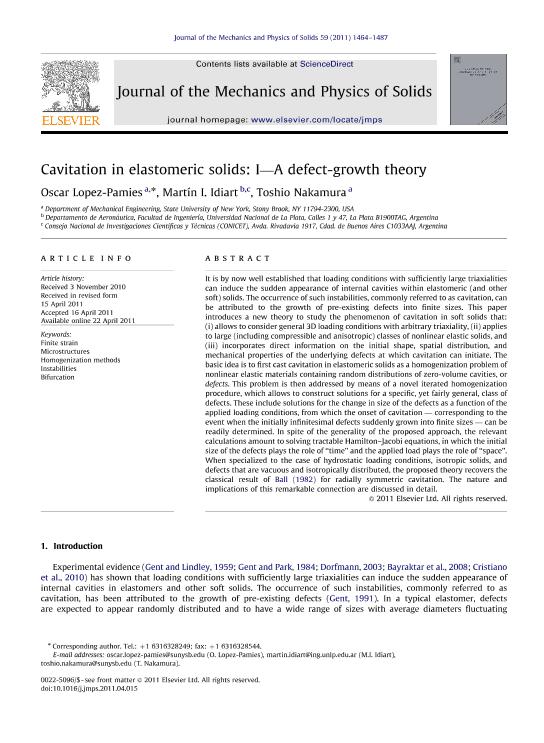Mostrar el registro sencillo del ítem
dc.contributor.author
Lopez Pamies, Oscar
dc.contributor.author
Idiart, Martín Ignacio

dc.contributor.author
Nakamura, Toshio
dc.date.available
2020-01-17T19:51:22Z
dc.date.issued
2011-08
dc.identifier.citation
Lopez Pamies, Oscar; Idiart, Martín Ignacio; Nakamura, Toshio; Cavitation in elastomeric solids: I—A defect-growth theory; Pergamon-Elsevier Science Ltd; Journal of the Mechanics and Physics of Solids; 59; 8; 8-2011; 1464-1487
dc.identifier.issn
0022-5096
dc.identifier.uri
http://hdl.handle.net/11336/95092
dc.description.abstract
It is by now well established that loading conditions with sufficiently large triaxialities can induce the sudden appearance of internal cavities within elastomeric (and other soft) solids. The occurrence of such instabilities, commonly referred to as cavitation, can be attributed to the growth of pre-existing defects into finite sizes. This paper introduces a new theory to study the phenomenon of cavitation in soft solids that: (i) allows to consider general 3D loading conditions with arbitrary triaxiality, (ii) applies to large (including compressible and anisotropic) classes of nonlinear elastic solids, and (iii) incorporates direct information on the initial shape, spatial distribution, and mechanical properties of the underlying defects at which cavitation can initiate. The basic idea is to first cast cavitation in elastomeric solids as a homogenization problem of nonlinear elastic materials containing random distributions of zero-volume cavities, or defects. This problem is then addressed by means of a novel iterated homogenization procedure, which allows to construct solutions for a specific, yet fairly general, class of defects. These include solutions for the change in size of the defects as a function of the applied loading conditions, from which the onset of cavitation — corresponding to the event when the initially infinitesimal defects suddenly grown into finite sizes — can be readily determined. In spite of the generality of the proposed approach, the relevant calculations amount to solving tractable Hamilton–Jacobi equations, in which the initial size of the defects plays the role of “time” and the applied load plays the role of “space”. When specialized to the case of hydrostatic loading conditions, isotropic solids, and defects that are vacuous and isotropically distributed, the proposed theory recovers the classical result of Ball (1982) for radially symmetric cavitation. The nature and implications of this remarkable connection are discussed in detail.
dc.format
application/pdf
dc.language.iso
eng
dc.publisher
Pergamon-Elsevier Science Ltd

dc.rights
info:eu-repo/semantics/openAccess
dc.rights.uri
https://creativecommons.org/licenses/by-nc-sa/2.5/ar/
dc.subject
FINITE STRAIN
dc.subject
MICROSTRUCTURES
dc.subject
HOMOGENIZATION METHODS
dc.subject
INSTABILITIES
dc.subject
BIFURCATION
dc.subject.classification
Mecánica Aplicada

dc.subject.classification
Ingeniería Mecánica

dc.subject.classification
INGENIERÍAS Y TECNOLOGÍAS

dc.title
Cavitation in elastomeric solids: I—A defect-growth theory
dc.type
info:eu-repo/semantics/article
dc.type
info:ar-repo/semantics/artículo
dc.type
info:eu-repo/semantics/publishedVersion
dc.date.updated
2020-01-15T20:05:46Z
dc.journal.volume
59
dc.journal.number
8
dc.journal.pagination
1464-1487
dc.journal.pais
Países Bajos

dc.journal.ciudad
Amsterdam
dc.description.fil
Fil: Lopez Pamies, Oscar. State University of New York; Estados Unidos
dc.description.fil
Fil: Idiart, Martín Ignacio. Universidad Nacional de La Plata. Facultad de Ingeniería. Departamento de Aeronáutica; Argentina. Consejo Nacional de Investigaciones Científicas y Técnicas; Argentina
dc.description.fil
Fil: Nakamura, Toshio. State University of New York; Estados Unidos
dc.journal.title
Journal of the Mechanics and Physics of Solids

dc.relation.alternativeid
info:eu-repo/semantics/altIdentifier/url/https://www.sciencedirect.com/science/article/pii/S0022509611000858
dc.relation.alternativeid
info:eu-repo/semantics/altIdentifier/doi/http://dx.doi.org/10.1016/j.jmps.2011.04.015
Archivos asociados
